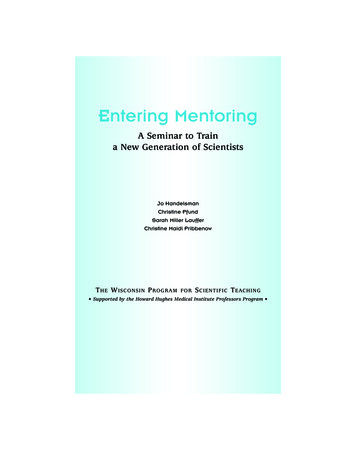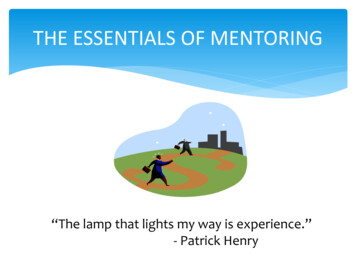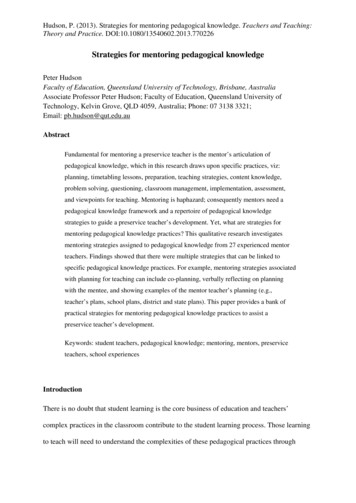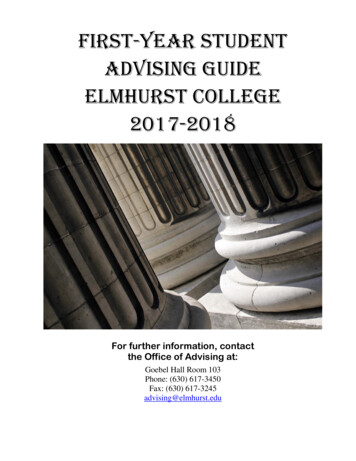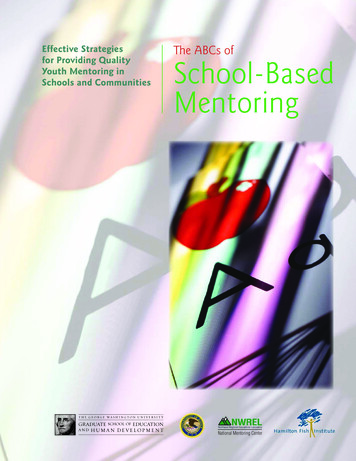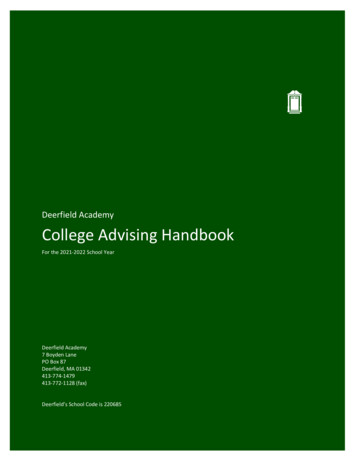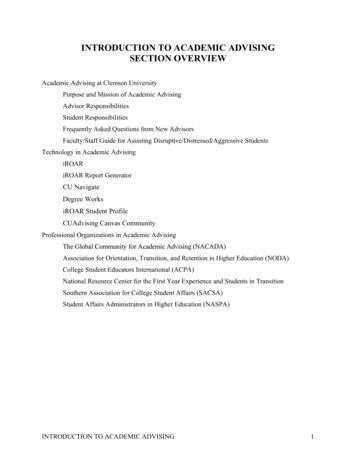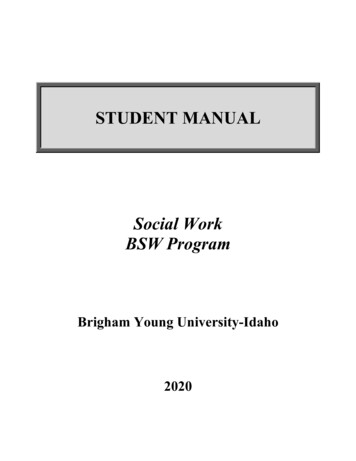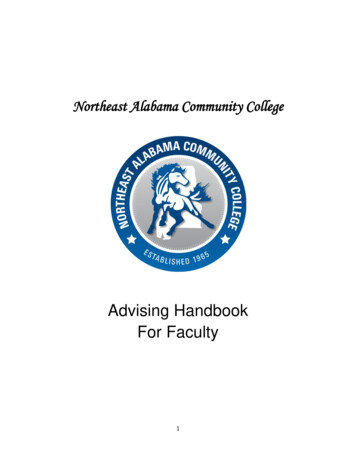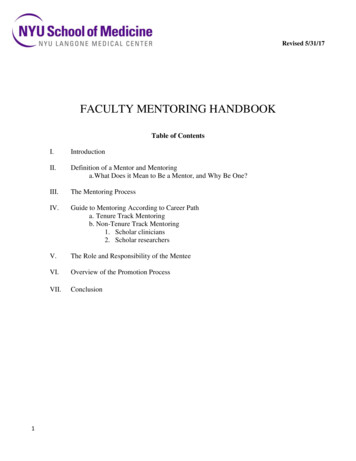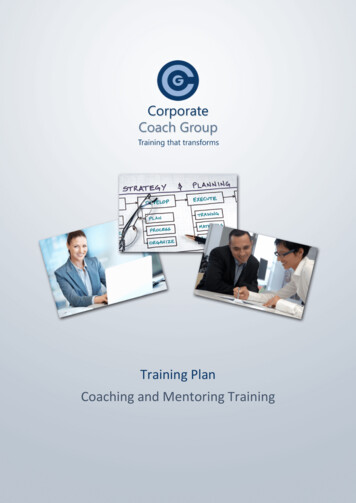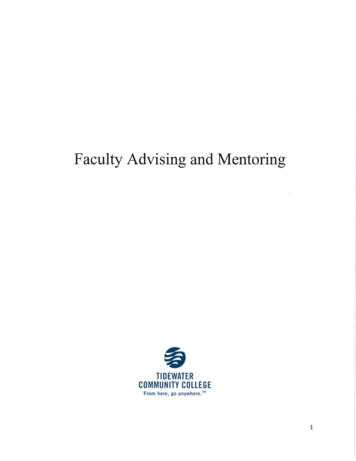
Transcription
Faculty Advising and MentoringTIDEWATERCOMMUNITY COLLEGEFrom here, go anywhere. 11'11
ContentsINTRODUCTION: . . 3RATIONALE: . . 3LITERATURE REVIEW: . 5THE PROCESS: . . 6Overview: . . . 6The Role of Student Mentees: .7The Role of Counselors: . 7The Role of Faculty Mentors: . 7Pilot Programs: . 8Criteria: . 8Recruitment: . 9ADVISOR TRAINING: . 9PROGRAM ASSESSMENT: . . 9CONCLUSION: . . 10REFERENCES: . . . 112
Faculty Advising and MentoringINTRODUCTION:"Advising is an opportunity to teach our students crucial planning skills that will be invaluablebeyond the student's academic career."(NOVA QEP, p.3) This proposal originated from theNOVA model of faculty advising, which is based on their current "Achieve the Dream" Grant.This model focuses on the benefits of increased student/faculty relationships, mentorship byfaculty in the student's chosen major after their first year, and the potential impact that thisguidance and advice will have on student success. Our proposal includes a template forrecruiting interested faculty, training faculty volunteers, and a potential timeline forimplementation. Desired outcomes include: increased retention and student engagement,increased graduation rates, increased transfer rates, increased job readiness skills, and a moreinformed student as related to the world of work. This is based on the assumption that there is adirect correlation between education, academic preparation, and career goal development.RATIONALE:Emphasis on faculty in a mentoring role is not a novel concept, as best practices based on theCouncil for the Advancement of Standards in Higher Education (CAS) have noted. We havechosen a proactive approach that focuses not only on the student's academic preparation, but thepersonal development of the student as well. Hopefully, as a result of this mentoring experience,students will develop and/or refine personal goals and enhance their knowledge, skills, andunderstanding in order to make informed educational, social, and career decisions.Discovering one's interests, skills, values, and abilities are crucial career development tools thattake time to master, and are best achieved through a mentoring experience with individuals whohappen to be the student's faculty. Understanding how to deal with barriers and challenges,developing self-confidence, personal enrichment, and identifying various resources for andpathways towards goals are a few of the many desired outcomes of such a faculty mentoringrelationship.Our faculty mentoring program seeks to redefine faculty advising such that we transform it froma mechanical class scheduling/course selection process into a more comprehensive model where"advising as teaching" becomes the central focus. The role the faculty plays in the process is acritical service. Inadequate academic advising has emerged as one of the strongest negativefactors in student retention. Faculty advising has a strong positive correlation with student3
retention. Key points include a stronger connection to the institution, student satisfaction, andincreasing student retention and student engagement based on several key factors and realitiessuch as: course sequencing, prerequisites, complexity of graduation requirements, and the degreeto which an advisor must approve a variety of transactions such as clearing student groups. Thebenefits of an early connection with faculty in one's major have been recognized nationally forsome time. These benefits include the following: Connecting faculty and students through reflective discussion in the student's area ofstudy.Developing critical thinking skills.Improving organizational skills, academic planning and preparation.Creating opportunities for engaging students through collaborative learning.Leaming firsthand what the day-to-day work experiences entail from those currently intheir desired fields.4
LITERATURE REVIEW:As described in the CAS Standards and Guidelines for Academic Advising Programs, "theprimary purpose of Academic Advising Programs (AAP) is to assist students in the developmentof meaningful educational plans" (CAS 2005 p.3).While much of the prevailing research focuses on the role and significance of advising, many ofthose approaches also address the importance of mentoring. The mentoring relationship that isborn out of academic advising is the single most important relationship offered to students by aninstitution of higher education. Through this relationship, students will engage in a criticalnarrative process giving shape and meaning to their curricular and life choices. (McGillan, 2003,p.88). Tinto (1993), a national leader in retention research of college students, emphasizes theimportance of student-faculty interaction outside the classroom and the positive influence that itcan have on student development of critical decision making skills, student satisfaction andstudent persistence.There is a trend toward what Pardee (2004) describes as an ideal shared structure which takesadvantage of expertise of departmental faculty advising while relying on professional advisors incentral administrative units to meet the special needs of students.Post-secondary institutions most often use either a faculty-only or counselor/advisor-only modelof academic advising. Kuhn notes that there is a trend away from these models at communitycolleges, recognizing that effective undergraduate education requires academic affairs andstudent affairs to work together to deliver an education that reflects how the student learns. King(2008) explains that there is a need for both academic and student affairs to unite and worktogether to provide quality academic advising (Kuhn 2008).Given the complexity of academic advising, it is unrealistic to expect any one entity toadequately address every concern. It is also important that there be sufficient resources availableto address students' advising needs in a timely manner and to accomplish the mission and goalsof the advising program. Sharing the advising responsibilities makes this a more feasible process.(CAS Standards, 2011 p. 248).It should be noted however that research by Upcraft, Gardner & Barefoot (2005) highlightseveral sobering realities: "As the institution looks at the role faculty should and will play, it isimportant to consider faculty interest in advising, their awareness of existing problems, and theirwillingness to address these problems and accept training. Faculty interest and willingness maybe affected by other responsibilities, how the administration values advising, and the reward forgood advising." In institutions where all faculty were required to advise, varying degrees ofcommitment were noted, resulting in inconsistent advising quality.5
This proposal is based on a voluntary model where participation and commitment is encouragedbut not mandated. It is directly aligned with the faculty evaluation process and promotionalopportunities, recognizing that a positive correlation exists between demonstration of initiative,innovation and institutional commitment to overt recognition and reward for those acts. Upcraft,Gardner & Barefoot (2005) offers the following observation: "Other than consideration inpromotion and tenure decisions, the most frequent methods that colleges and universities use toprovide recognition and reward for both faculty and professional advisors are release time,support for travel to conferences, annual campus rewards and external recognition."In summary, Pascarella ( 1980) suggests that there is a positive correlation between student faculty interaction outside the classroom and the various student outcome measures such asacademic achievement, positive views of their college experience, personal and intellectualgrowth and development, engagement and persistence. "Significant positive associations existbetween extent and quality of student-faculty informal contact and students' educationalaspirations, their attitudes toward college, their academic achievement, intellectual and personaldevelopment, and their institutional persistence." This author maintains that students'perceptions of "warm" and "informal" relationships with faculty increase their level ofeducational aspirations, hope and persistence. Student-faculty interaction outside the classroomseems to have a positive correlation to student satisfaction with the college experience more sothan any other student or institutional characteristic.THE PROCESS:Since faculty play such an integral role in academic advising, it is imperative that all constituentswork together to assure that faculty have the infonnation, tools and resources to effectivelyengage in the advising process.Overview:This model focuses on students learning the processes needed to complete their educational goalsat Tidewater Community College. It follows a shared governance model to advising based on aholistic approach to student success, and provides faculty an opportunity to satisfy theirinstitutional responsibility requirement. Students will be eligible to participate in the facultyadvising/mentoring program with a full-time faculty member, ideally, specific to theircurriculum.Key components of an effective faculty advising and mentoring program include the following: A clear definition and common understanding of what faculty advising and mentoringentails.Systematic and ongoing training for faculty.6
A system that is evaluated regularly for clarity of goals, and specific measurableoutcomes, as well as a willingness to modify as deemed necessary for the overall successof the program.Faculty who participate may receive recognition and rewards for their efforts such asrelease time, support for professional development, etc.A designated individual or working committee to coordinate the program, who willreceive release time to do so.The advising team will be composed of counselors, CMVE advisors, faculty volunteers,academic dean volunteers, and student ambassadors. All stake holders will be cross-trained inadvising, student success theories and best practices. Faculty will receive technological supportand training, opportunities to participate in additional training throughout the semester to honetheir advising skills if needed. All students intending to transfer will continue to work with thetransfer counselors for advising and academic planning.The Role of Student Mentees: Establish a relationship with the faculty mentor during the registration period that willcontinue through their time at TCC.Develop academic goals and a program completion plan with the assistance of the facultymentor.Periodically meet with the faculty mentor to evaluate their academic plan, as well asparticipate in the process of achieving the established mentoring goals described above.The Role of Counselors: Counselors and advisors will be assigned a curricula, will partner with facultyadvisors/mentors within the assigned curricula, and maintain that collaborativerelationship through degree completion.The Role of Faculty Mentors: Proactively establish a relationship with the student mentee that encompasses academic,career and professional advising. The faculty-advi sor/mentor will be the first point ofcontact for academic advising and class selection after the First Year Experience iscompleted.Assist the student in the evaluation of their academic performance, helping to instill traitssuch as self-accountability, follow through and persistence.I Assist students in the development of an academic plan to ensure program completion.Faculty-advising/mentorship will occur prior to the beginning of registration, at the mid term point and after classes have ended to assess course completion of the currentsemester and plan for the upcoming semester.7
Faculty advisors/mentors will be available to students via appointment during officehours, as well as at designated times and locations during the advising and registrationperiod.Recognizing the need to document attainment of established advisement outcomes, a system willbe implemented, perhaps using Blackboard, where both advisors and advisees can reviewestablished goals and progress made towards attainment of these goals. This will serve to furthercement the mentoring relationship. Setting measurable outcomes will sharpen the college's focuson providing a program that produces direct measurable benefits to our students.Pilot Programs:Full-time faculty advising/mentorship will be offered as a pilot with certain applied sciencecurriculums and certificate programs. They have been selected by the committee and are asfollows:CampusCurriculumChesapeakeAdministration of Justice, Early Childhood &Human ServicesNorfolkCulinary Arts, Early Childhood & HumanServicesPortsmouthNursing, Welding & Visual ArtsVirginia BeachInformation Systems Technology, Paralegal,Early Childhood & Health ProfessionsCriteria:In order to provide the best mentoring experience for our students, it is important to haveuniform expectations for participating faculty; therefore, the following criteria has beenestablished: Must be full-time faculty.Must be appointed to at least the second year of the current one year contract.Must have successfully met evaluation expectations for their previous evaluationperiod.Must have a willingness to participate in an extensive training process.Must commit to maintaining required advising hours.Must participate with the Faculty Mentoring program for at minimum of two years.8
Recruitment:Recruitment will begin by soliciting volunteers from the participating programs, initially thosewhich have agreed to participate in the pilot. The following recruitment process will be used toselect the mentors from among the volunteers: Interested faculty will complete an application to be reviewed by the selectioncommittee.Applications will be available March 1st through April 1 st each academic year.Mentoring appointments begin each fall semester for a two consecutive year term.The selection committee will be comprised of a faculty peer appointed by the campusFaculty Senate, counselor appointed by the campus Dean of Student Services, and astudent representative appointed by the campus student SGA.This recruitment process outlined above would be repeated on an ongoing basis uponsuccessful completion of the pilot and final approval by the college-wide facultysenate.ADVISOR TRAINING:This proposal supports the premise that faculty advising and mentoring is much more than courseselection. It is a complex process that requires extensive knowledge of the respective curricula,strong interpersonal skills, and motivation to establish and maintain a relationship with ourstudents outside the classroom. Since faculty will play such an integral role in academicadvising, it is imperative that they have the information, tools and resources to effectively engagein the advising and mentoring process. ·Intended outcomes for the advisor training program willinclude, but are not limited to, the following: Gain a thorough understanding of college policies and procedures relevant to advising.Obtain a thorough knowledge of their program's curriculum and degree requirements.Identify student needs that may be potential inhibitors to their academic success.Acquire a working knowledge of the appropriate resources for additional supportincluding necessary referrals. Assist their students in a review of their academic history and development of acomprehensive success plan.PROGRAM ASSESSMENT:Ongoing assessment of the program will be completed annually through the use of surveys tosolicit feedback from program participants (mentors and mentees) to determine whether studentexpectations are being met and the training provided to the faculty mentors adequately preparedthem for their role. The specific assessment criteria will be developed by the pilot programparticipants and those charged with program oversight. These criteria may include, but are not9
limited to, the following areas: Efficacy of the training program in preparing mentors to identify and meet student'sacademic, professional, and personal needs.Suggested areas for improvement to the training program going forward.Student feedback regarding the quality and effectiveness of the mentor-menteerelationship.CONCLUSION:The introduction of faculty mentoring is a positive step toward ensuring students have access toall available resources in order to maximize their potential while attending TCC. Analysis ofcomprehensive data shows that the current proposal brings TCC into alignment not only withother VCCS institutions, but also with leading colleges and universities nationally. Our researchsupports the premise that the most effective model of student-faculty mentoring relationships atTCC would be a shared model reflecting collaboration between students, student services, andfaculty. Variations of such a model are informally in place at our campuses presently; however,realignment of current practices to a common model which emphasizes early and continualengagement with a mentor will improve students' overall success.Respectfully submitted by the 2014-15 Student Success Governance Committee.Revision: 5/14/1510
REFERENCES:**Association of American Colleges and Universities. (2006). College learning for the newglobal century.Washington, DC: Association of American Colleges and Universities.**Campbell, S. M. (2008). Vision, mission, goals, and program objectives for academic advisingprograms. In V. N. Gordon, W.R. Habley, & T. J. Grites (Eds.), Academic advising: Acomprehensive handbook (2nd ed.) (pp. 229-241). San Francisco: Jossey-Bass**Council for the Advancement of Standards in Higher Education (CAS). (2005). Academicadvising programs: CAS standards and guidelines. Retrieved April 8, 2010 fromhttp://www .cas.edu/getpdf.cfm?PDF E864D2C4-D6558F74-2E647CDECD29B7DO**Council for the Advancement of Standards in Higher Education. (2006, 2009). CASprofessional standards for higher education, (6th and 7th ed.). Washington, DC: Author.**Habley, W. R. (Ed.). (2004). The status ofacademic advising: Findings from the ACT SixthNational Survey. (NACADA Monograph Series, no. 10) Manhattan, KS: National AcademicAdvising Association.**King, M. C. (2008). Organization of academic advising services. In V. N. Gordon, W.R.Habley, & T. J. Grites (Eds.), Academic advising: A comprehensive handbook (2nd ed.) (pp.242-252). San Francisco: Jossey-Bass.**Kuhn, T. L. (2008). Historical foundations of academic advising. In V. N. Gordon, W . R.Habley, & T. J. Grites (Eds.), Academic advising: A comprehensive handbook (2nd ed.) (pp. 3 16). San Francisco: Jossey-Bass.**McGillan, V. A. (2003). The role of evaluation and reward in faculty advising. In G. Kramer(ed.), Faculty advising examined: Enhancing the potential ofcollege faculty as advisors (pp. 8 8 124). Bolton, MA: Anker.**M. L. Upcraft, J. Gardner, & B. Barefoot (2005). Challenging and Supporting the First-YearStudent : A Handbook for Improving the First Year of College; San Francisco: Jossey-Bass.**National Academic Advising Association. (2006). NACADA concept of academic advising.Retrieved April 19, 2011 from the NACADA Clearinghouse of Academic Advising ResourcesWeb site: http://www.nacada.ksu.edu/Clearinghouse/ Advisingissues/Concept-Advising.htm**Northern Virginia Community College (NOVA), Quality Enhancement Plan (2012). GPS forSuccess: Teaching and learning through Academic Advisement.**O'Banion, T. (1972). An academic advising model. Junior College Journal, 42(6), 62 69. Reprinted (1994). NACADA Journal, 14(2), 10-16.11
**Pardee, C. F. (2004). Organizational structures for advising. Retrieved January 25, 2011 fromthe NACADA Clearinghouse of Academic Advising Web site:http://www.nacada.ksu.edu/Clearinghouse/ Advisi nglssues/org models.htm**Pascarella, E.T., Terenzini, P. T. (1980). Patterns of student-faculty informal interactionbeyond the classroom and voluntary freshman attrition. Journal of Higher Education, 48(5), 540 552.**Tinto, V. ( 1993). Leaving college: Rethinking the causes and cures ofstudent attrition (2nded.). Chicago: University of Chicago Press.12
advising/mentoring program with a full-time faculty member, ideally, specific to their curriculum. Key components of an effective faculty advising and mentoring program include the following: A clear definition and common understanding ofwhat faculty advising and mentoring entails. Systematic and ongoing training for faculty. 6
